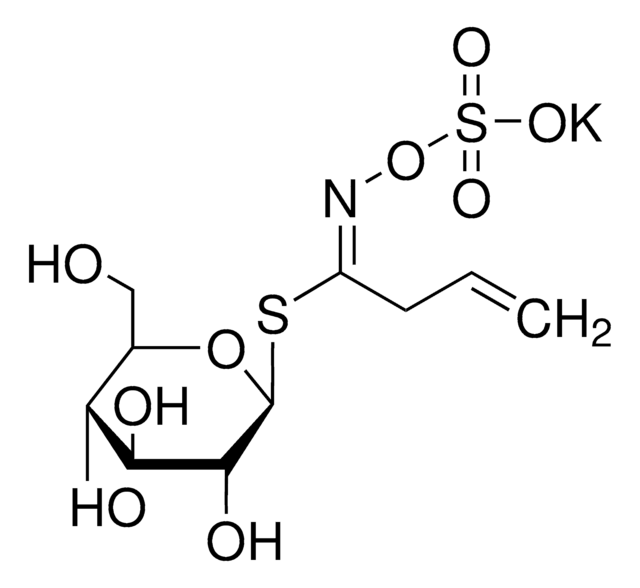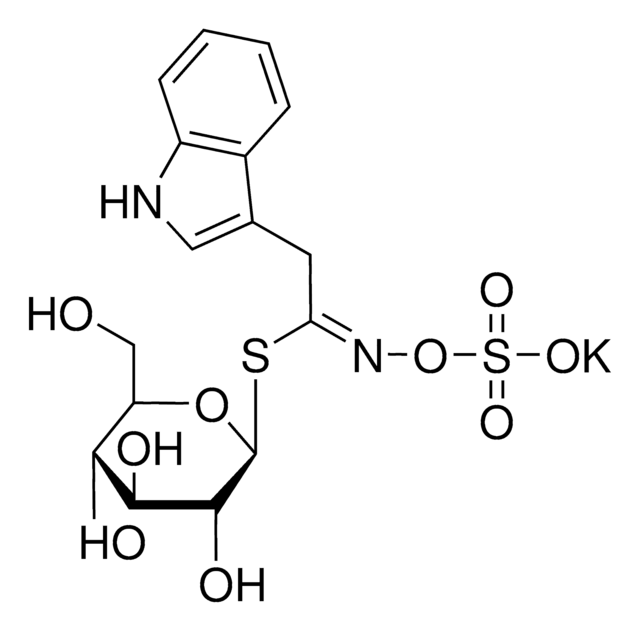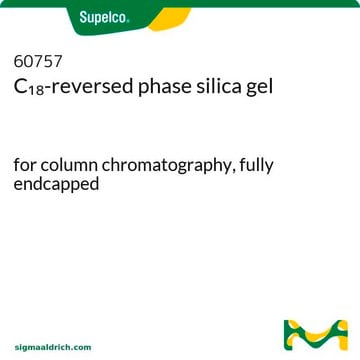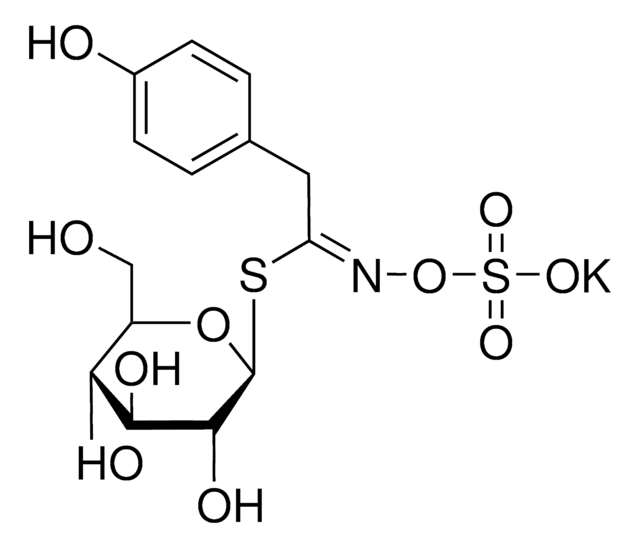T4528
Thioglucosidase from Sinapis alba (white mustard) seed
≥100 units/g solid
Sinónimos:
Glucosinolase, Thioglucoside glucohydrolase
Iniciar sesiónpara Ver la Fijación de precios por contrato y de la organización
About This Item
Número de CAS:
MDL number:
UNSPSC Code:
12352204
NACRES:
NA.54
Productos recomendados
biological source
plant seeds (Sinapis alba)
form
solid
specific activity
≥100 units/g solid
storage temp.
−20°C
Categorías relacionadas
General description
Thioglucosidase, also called as myrosinase, is present in the myrosin cells that do not contain glucosinolates. This enzyme is obtained from several plant sources, such as Lepidium sativum, L. Sinapis alba and Brassica napus.
Application
Thioglucosidase from Sinapis alba (white mustard) seeds has been used as a standard to quantify myrosinase activity and in column glucosinolate analysis of plant samples.
Thioglucosidase has been used in a study to assess Brassica species screening for glucosinolate content. Thioglucosidase has also been used in a study to investigate a negative regulatory role for auxin in sulphate deficiency response in Arabidopsis thaliana.
Biochem/physiol Actions
Thioglucosidase research has focused mainly on the cruciferous crops due to their economic importance and cancer preventive benefits.
Myrosinases are present in many bacteria, fungi, and edible plants, including those of the Brassicaceae (Cruciferae) family. The enzyme hydrolyzes the S-glucosidic bond of a glucosinolate substrate to form an unstable aglycone that rearranges with the loss of sulfate primarily to the isothiocyanate, though thiocyanates and nitriles are also formed. Many of the isothiocyanate products of aliphatic and aromatic glucosinolates have cancer chemopreventive properties.
Unit Definition
One unit will produce 1.0 μmole glucose per min from sinigrin at pH 6.0 at 25 °C.
signalword
Danger
hcodes
pcodes
Hazard Classifications
Resp. Sens. 1
Storage Class
11 - Combustible Solids
wgk_germany
WGK 3
flash_point_f
Not applicable
flash_point_c
Not applicable
ppe
Eyeshields, Gloves, type N95 (US)
Certificados de análisis (COA)
Busque Certificados de análisis (COA) introduciendo el número de lote del producto. Los números de lote se encuentran en la etiqueta del producto después de las palabras «Lot» o «Batch»
¿Ya tiene este producto?
Encuentre la documentación para los productos que ha comprado recientemente en la Biblioteca de documentos.
Los clientes también vieron
Teresa Oliviero et al.
Molecular nutrition & food research, 62(18), e1700837-e1700837 (2018-03-14)
Optimization of bioavailability of dietary bioactive health-beneficial compounds is as important as increasing their concentration in foods. The aim of this study is to explore the change in bioavailability of isothiocyanates (ITCs) in broccoli sprouts incorporated in protein, fiber, and
George F Antonious et al.
Journal of environmental science and health. Part. B, Pesticides, food contaminants, and agricultural wastes, 44(3), 311-316 (2009-03-13)
Glucosinolates (GSLs), a group of compounds found in Brassica plants, are toxic to some soil-borne plant pathogens because of the toxicity of their hydrolysis products, isothiocyanates. Other phytochemicals found in Brassica plants, such as phenols and ascorbic acid, may compliment
Wei Chen et al.
Frontiers in physiology, 13, 1013092-1013092 (2022-11-08)
Glycoside hydrolase family 1 (GH1) members exhibit a broad substrate spectrum and play important roles in insect-plant interactions, such as the defensive β-glucosidase and β-thioglucosidase (so-called myrosinase). However, knowledge about the expression profiling and function of glycoside hydrolase family 1
Niels Agerbirk et al.
Phytochemistry, 153, 79-93 (2018-06-11)
Glucosinolates are found in plants of the order Brassicales and hydrolyzed to different breakdown products, particularly after tissue damage. In Barbarea vulgaris R.Br. (Brassicaceae), the dominant glucosinolate in the investigated "G-type" is glucobarbarin, (S)-2-hydroxy-2-phenylethylglucosinolate. Formation of the nitrile from glucobarbarin
Chimgee Baasanjav-Gerber et al.
Molecular nutrition & food research, 55(5), 783-792 (2011-01-08)
Juices from Brassicales are mutagenic in Salmonella typhimurium and characteristic adducts are formed with the endogenous DNA in Brassicales homogenates. These effects require myrosinase activity, suggesting an involvement of breakdown products of glucosinolates (GLs). We aimed to identify GLs congeners
Nuestro equipo de científicos tiene experiencia en todas las áreas de investigación: Ciencias de la vida, Ciencia de los materiales, Síntesis química, Cromatografía, Analítica y muchas otras.
Póngase en contacto con el Servicio técnico

















